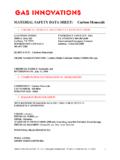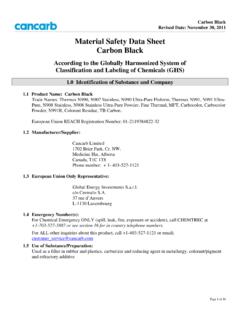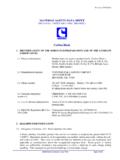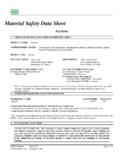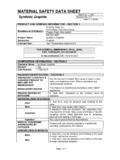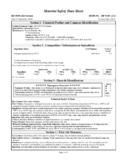Transcription of MATERIAL SAFETY DATA SHEET - Astlett Rubber
1 MATERIAL SAFETY data SHEET . SECTION I. Product Name and Company Identification Trade Name: carbon Black CHEMICAL NAME: carbon (Amorphous). SECTION II. Composition/Information on Components Component: carbon Black (Amorphous carbon ). CAS Number: 1333-86-4. Weight, % 100. SECTION III. Hazards for Man and Environment POSSIBLE EFFECT ON HEALTH. EYE: carbon black may produce eye irritation. SKIN CONTACT: The product is not skin irritant. INFILTRATION Infiltration is not probable, carbon black being a dry THROUGH SKIN: solid MATERIAL . INGESTION: Specific effect is not known. INHALATION: At high concentrations of carbon black dust (above TLV) inhalation may produce irritation of lungs. SECTION IV. Fist AID. EYE Flush with water.
2 SKIN Wash with soap and water. INGESTION Usually no hazardous effect is produced. INHALATION Go out into open air. SECTION V. Fire Fighting Procedures COMBUSTIBILITY. FLASH POINT N/A. INFLAMMABILITY IN AIR May inflame at temperatures above 250 C. LOWER EXPLOSIBILITY LIMIT (LEL) 60 *. UPPER EXPLOSIBILITY LIMIT (UEL) N/A. EXTINGUISHING MEDIA Atomized jet of water. UNUSUAL FIRE HAZARDS carbon monoxide and carbon dioxide are generated during combustion of carbon black. The product burns (smolders) without flame, therefore in some cases combustion of carbon black cannot be detected, cases combustion of carbon black cannot be detected, unless the product is stirred and sparks are produced. HAZARDS OF DUST EXPLOSION carbon black does not explode easily, so it is not considered hazardous in practical applications.
3 However, in certain test conditions mixture of carbon black dust and air may explode. * Reported data on LEL differ. We take the value from The Handbook of Powder Technology, ed. by , , as being the lowest in litereture. SECTION VI. Procedures in Case MATERIAL is Released or Spilled Collect with vacuum cleaner, sweep up or sprinkle with water and collect in refuse container. SECTION VII. Handling and Storage Store in containers and indoors. Not to expose to open fire or strong oxidizers. Check for carbon monoxide and oxygen content in air before entering container or workroom. If carbon monoxide is present or oxygen is low use adequate gas masks. Produce less dust in air. Collect all spilled MATERIAL immediately.
4 SECTION VIII. Limiting Exposure and Personal Protective Measures INHALATION STANDARDS Maximum carbon black dust content in air by standards is , by German standards 6. , by Ukrainian standards 4 , by standards 3,5 BREATH PROTECTION Not required in normal conditions. If dust content in air is above recommended limit use protective mask that conforms to European, national, and local regulations. SKIN PROTECTION Not required. Use of protective gloves is not necessary. EYE PROTECTION Use protective glasses or goggles. PROTECTIVE CLOTHING Not required. TECHNICAL CONTROL Adequate ventilation is recommended that should keep dust content in air under the standard limit SECTION IX. Physical data APPEARANCE Amorphous solid MATERIAL in the form of to mm black-colored pellets.
5 ODOR Odorless BOILING POINT N/A. VAPOR PRESSURE N/A. VAPOR DENSITY N/A. SOLUBILITY IN WATER Insoluble RATE OF VAPORISATION N/A. SPECIFIC WEIGHT (Water=1) to POUR DENSITY 150 to 650 (ASTM D1518). VISCOSITY N/A. SECTION X. Stability and Reactivity STABILITY Product is stabile INCOMPATIBILITY (MATERIALS TO AVOID) Strong oxidizers such as liguid oxygen, chlorates, bromates, nitrates. CONDITIONS TO AVOID Excessive heating, exposure to open fire. HAZARDOUS DECOMPOSITION PRODUCTS carbon monoxide and dioxide are produced in combustion. HAZARDOUS POLYMERIZATION No polymerization occurs. SECTION XI. Toxicological data EYE. ACUTE Slight irritation CHRONIC Slight irritation SKIN. ACUTE Not expected CHRONIC Not expected INGESTION.
6 ACUTE Not expected CHRONIC Not expected INHALATION. ACUTE Dust in concentrations above TLV may cause transient irritation of upper respiratory tract. CHRONIC Research in USSR showed high incidence of respiratory tract diseases, including pneumoconiosis, emphysema, rhinitis. It is to be noticed that dust concentrations were above TLV in that research. On the other hand, ACGIH Committee on TLV classified carbon black as dust that causes inconvenience with no proved pathological or harmful changes of structure or function of lungs. No carcinogenic effect of carbon black on animals or man was established. Research on humans in USA gave no evidence of carbon black dust concentrations equal to or below TLV in workrooms causing respiratory tract diseases.
7 OTHER Oral LD50 > 10000 mg/kg (rat). CARCINOGENIC EFFECT The International Agency for Research on Cancer (IARC), the National Toxicology Program (NTP), the Occupatioal SAFETY and Health Administrati- on (OSHA) do not classify carbon black as carcinoge- nic MATERIAL . SECTION XII. Ecological data No negative effect on environment has been established. SECTION XIII. Waste Disposal Neither in Ukraine nor in Europe (Directive 78/319/EEC) carbon black is classified as toxic or hazardous waste. Waste may be incinerated or buried, observing all European, national, and local regulations. SECTION XIV. Transportation According to the rules of transportation established by Ukrainian Ministry of Railroad, carbon black is classified as self-igniting hazardous MATERIAL , Class 4, Subclass , and is supplied with Emergency Card 47.
8 It may be transported in bulk in special hopper cars or packed in containers. In most European countries and in the USA carbon black is not considered hazardous MATERIAL and may be shipped by land, sea, or air transpor without limitations. SECTION XV. Legal Information Labeling Requirements carbon black, CAS No. 1333-86-4, is included in following inventories : All-Union Classifier of Industrial and Agricultural Products (Ukraine);. Toxic Substances Control Act (TSCA);. European Inventory of Existing Chemical Substunces (EINESC - No. 215-609-9);. Canadian Domestic Substances List (DSL);. Australian Inventory of Chemical Substances (AICS);. List of Existing Chemical Substances of Japanese Ministry of international Trade and Industry (MITI).
9 Korean Toxic Chemicals Control Law ( TCCL). Classification according to Ukrainian Standards : Hazard symbol and labeling-according GOST 19433-88. Classification code 4213. UNO Classification No 1361. Classification according to European Standards : Symbol and Labeling for Huzard : None Components of Labeling for Risks : None R - Clauses : None S - Clauses : None SECTION XVI. Other Information TEXT ON LABEL : carbon Black The preceding data are based on test results that we consider reliable. However, we cannot guarantee them or take responsibility for the consequences of their use. Users are to conduct their own research in order to determine whether the data or products are suitable for their specific applications.
10 None of the data reported here are to be understood as permission, suggestion, or recommendation for infringement of any laws or application of any inventions protected by patents in force. This MATERIAL SAFETY data SHEET is provided courtesy of Astlett Rubber Inc. Visit our website at for more information.


